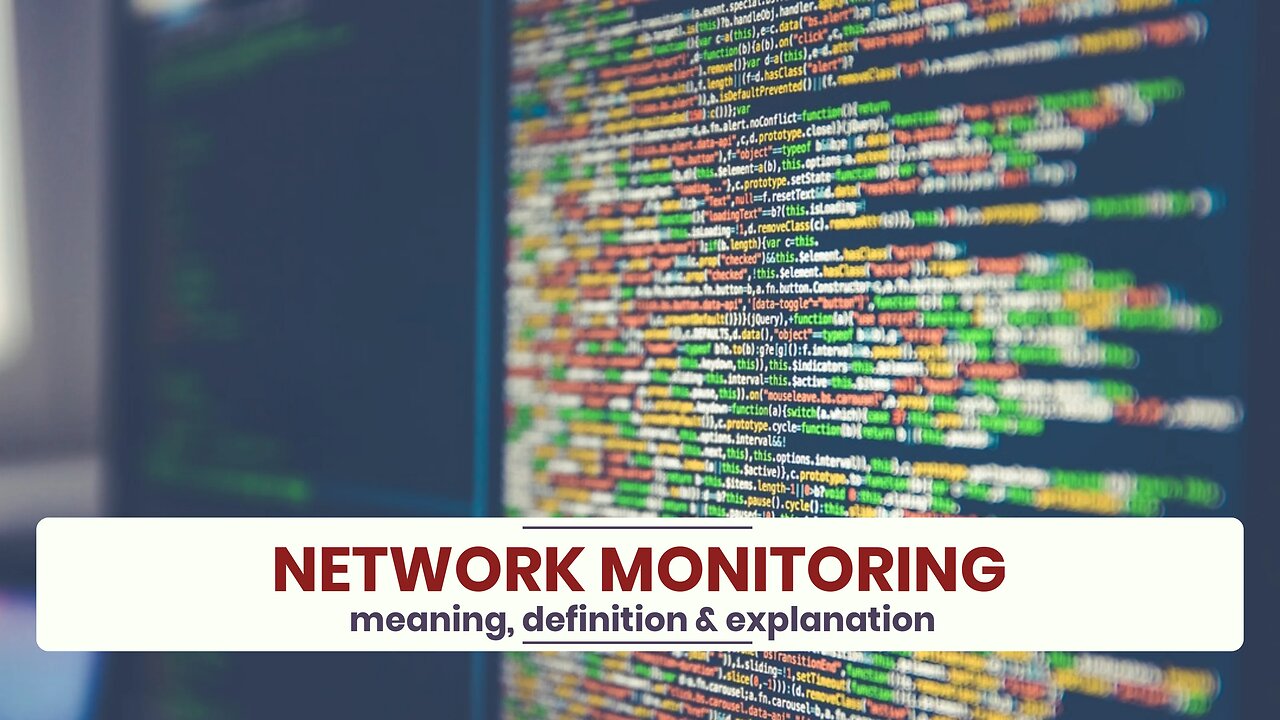Premium Only Content

What is NETWORK MONITORING?
✪✪✪✪✪
http://www.theaudiopedia.com
✪✪✪✪✪
What does NETWORK MONITORING mean? NETWORK MONITORING meaning - NETWORK MONITORING definition - NETWORK MONITORING explanation. What is the meaning of NETWORK MONITORING? What is the definition of NETWORK MONITORING? What does NETWORK MONITORING stand for? What is NETWORK MONITORING meaning? What is NETWORK MONITORING definition?
Network monitoring is the use of a system that constantly monitors a computer network for slow or failing components and that notifies the network administrator (via email, SMS or other alarms) in case of outages or other trouble. Network monitoring is part of network management.
While an intrusion detection system monitors a network for threats from the outside, a network monitoring system monitors the network for problems caused by overloaded or crashed servers, network connections or other devices.
For example, to determine the status of a web server, monitoring software may periodically send an HTTP request to fetch a page. For email servers, a test message might be sent through SMTP and retrieved by IMAP or POP3.
Commonly measured metrics are response time, availability and uptime, although both consistency and reliability metrics are starting to gain popularity. The widespread addition of WAN optimization devices is having an adverse effect on most network monitoring tools, especially when it comes to measuring accurate end-to-end response time because they limit round trip visibility.
Status request failures, such as when a connection cannot be established, it times-out, or the document or message cannot be retrieved, usually produce an action from the monitoring system. These actions vary; An alarm may be sent (via SMS, email, etc.) to the resident sysadmin, automatic failover systems may be activated to remove the troubled server from duty until it can be repaired, etc.
Monitoring the performance of a network uplink is also known as network traffic measurement.
Network tomography is an important area of network measurement, which deals with monitoring the health of various links in a network using end-to-end probes sent by agents located at vantage points in the network/Internet.
Route analytics is another important area of network measurement. It includes the methods, systems, algorithms and tools to monitor the routing posture of networks. Incorrect routing or routing issues cause undesirable performance degradation or downtime.
Website monitoring service can check HTTP pages, HTTPS, SNMP, FTP, SMTP, POP3, IMAP, DNS, SSH, TELNET, SSL, TCP, ICMP, SIP, UDP, Media Streaming and a range of other ports with a variety of check intervals ranging from every four hours to every one minute. Typically, most network monitoring services test your server anywhere between once-per-hour to once-per-minute.
Monitoring an internet server means that the server owner always knows if one or all of his services go down. Server monitoring may be internal, i.e. web server software checks its status and notifies the owner if some services go down, and external, i.e. some web server monitoring companies check the services status with a certain frequency. Server monitoring can encompass a check of system metrics, such as CPU usage, memory usage, network performance and disk space. It can also include application monitoring, such as checking the processes of programs such as Apache, MySQL, Nginx, Postgres and others.
External monitoring is more reliable, as it keeps on working when the server completely goes down. Good server monitoring tools also have performance benchmarking, alerting capabilities and the ability to link certain thresholds with automated server jobs such as provisioning more memory or performing a backup.
-
 1:26
1:26
The Audiopedia
1 year agoWhat is MOTTO?
55 -
 2:07:27
2:07:27
Steven Crowder
4 hours agoWho Belongs: What the Future of the American Right Wing Looks Like
292K194 -
 1:29:28
1:29:28
NAG Podcast
20 hours agoSay Something Beyond W/MikeMac: DARKSIDE - Ep.11
181 -
 35:24
35:24
The Rubin Report
3 hours ago'Real Time' Crowd Goes Quiet as Bill Maher & Democrat Have a Tense Exchange About Zohran Mamdani
83.2K38 -
 LIVE
LIVE
Rebel News
1 hour agoTrump says he can play dirty, Canada-US trade talks off, BC to launch anti-tariff ad | Rebel Roundup
465 watching -
 2:26:58
2:26:58
Nikko Ortiz
3 hours agoValid Crashout's... |Rumble Live
4.28K1 -
 LIVE
LIVE
LFA TV
17 hours agoLIVE & BREAKING NEWS! | MONDAY 10/27/25
2,403 watching -
 LIVE
LIVE
StoneMountain64
1 hour agoBattlefield 6 Season 1 TOMORROW. Battle Royale? New Map + New Weapons!
113 watching -
 1:22:23
1:22:23
The Mel K Show
3 hours agoMORNINGS WITH MEL K -Signal to Noise: The International Framework is Balancing Out - 10-27-25
18.1K10 -
 LIVE
LIVE
Viss
3 hours ago🔴LIVE - Battle Royale Release Tomorrow! - Battlefield 6
127 watching